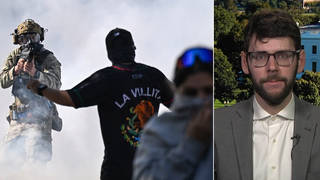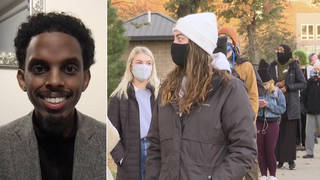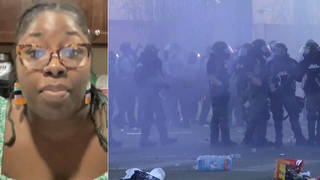
Guests
- Philip Stinsoncriminologist and associate professor at the Criminal Justice Program at Bowling Green State University.
As outrage grows in Minneapolis over the killing of an unarmed white Australian woman, we look at the staggering number of fatal police shootings in the United States. For more, we speak with Philip Stinson, criminologist and associate professor at the Criminal Justice Program at Bowling Green State University.
Transcript
AMY GOODMAN: We are joined by Phil Stinson, criminologist and associate professor at Criminal Justice Program at Bowling Green State University in Ohio. Professor Stinson, thanks for joining us. Also, you are a former cop. When you heard the description of what took place in Minneapolis, Mohammed Noor—oh, I might have said that he was the first Somali-American police officer in the country, but I believe in his precinct in Minneapolis—shooting across his partner through the window, after hearing—at least this is what we hear, because the story hasn’t come fully out—a loud sound, your thoughts?
PHILIP STINSON: I think we have to be careful. We don’t know all the facts yet, and we have to be careful with conjecture and speculation. But what we have heard is that the officer shot across his partner. Apparently, they had heard a loud noise, and there is some speculation that they thought they were going to be ambushed in the alleyway. So this raises a lot of questions.
But I have questions even before we get to the officers arriving on the scene. I don’t know why the 911 call taker did not keep the complaining witness on the phone until the officers arrived. They could gather more information about what was going on. They could tell them when to go outside to meet the officers or not to go outside to meet the officers. Why did it take 14 minutes for police officers to arrive? And it’s highly unusual and, frankly, bizarre that an officer would have an unholstered weapon, sitting in the front of a police car. And it’s ridiculous that the officer shot across his partner. So, there are many questions that are raised. Time will tell, hopefully, and answer some of these questions. One of the things that I’m concerned with: Is it possible that it was an accidental shooting? And we don’t know that yet.
JUAN GONZÁLEZ: Well, this whole issue of, obviously, the officer who fired his weapon not making any statements, and his partner making a limited statement that we have really no clear knowledge of exactly what he said, what’s the—what are the rules and regulations, and what are the legal rights of officers in these cases?
PHILIP STINSON: Well, if I were the officers’ attorney, I would advise them not to give a statement, especially in the immediate aftermath of a shooting. So, you know, they still have constitutional rights as police officers. There is a U.S. Supreme Court case from the 1960s, Garrity v. New Jersey, and every police officer in the country is familiar with that case. If an officer is required to make a statement after a shooting or in anything to do with their job, it cannot be used against them criminally if they’re required to make the statement. So they cannot be forced. It’s considered a coerced statement. So, it’s not unusual, in my mind, that the officers have not given statements at this time. It’s unfortunate. And we have seen a number of these cases—frankly, more than just a few—where the narratives that the officers give, either in written reports or verbally as they tell what happened, is inconsistent with the video evidence. So it is concerning that we don’t have, apparently, video evidence in this instance to tell us exactly what happened.
AMY GOODMAN: So, this is interesting. A local TV station did a study, and they found, in Minneapolis, where it’s not automatic that the video camera goes on, but the police have to initiate it themselves, that the average amount of time these video cams are on are something like five hours a month. How unusual is this, Phil Stinson?
PHILIP STINSON: Well, I don’t think it’s unusual at all at this time. Now, there are several things we have to keep in mind. The technology is still developing. It’s still fairly new that police officers are wearing body-worn cameras in this country. Frankly, there are not best practices that have been promulgated by the Justice Department. So, police departments across the country are left to their own devices to figure out what the policies should be. We have to consider a lot of logistical issues, as well. It costs money to maintain the video recordings, the cloud recordings. How—are we going to be able to keep all the recordings from all the video footage? How long are we going to be able to do that?
But I do think there’s a flawed policy, there’s a flawed practice, where you have officers who can decide when the cameras should be turned on, if they think there’s going to be some sort of problem situation. At that point, they’ve waited too long. So there are some new cameras that are coming onto the market where the on-off switch is actually controlled by a supervisor, not the officers on the street. So, in my view, officers on the street should have the body cameras rolling at all times. If they have dash cam videos, those should be recording on a loop, as well. It’s inexcusable that they’re wearing body-worn cameras and they were not turned on.
JUAN GONZÁLEZ: Now, Phil Stinson, you’ve been developing a database on police shootings nationwide. Could you talk about that database and what your preliminary findings are? And how big of a problem is police shootings in this country, say, compared to other nations?
PHILIP STINSON: Well, one of the problems is, we simply don’t have good data going back too many years. The best estimate that I can give you is that, over the last several years, on-duty police officers shoot and kill someone between 900 to 1,000 times each year. So, two to three times a day in this country, someone is shot and killed. That’s not even including the nonfatal shootings.
And I’ve been tracking officers who were charged with murder or manslaughter resulting from on-duty shootings since the beginning of 2005. To date, only 83 officers during that time period have been charged with murder or manslaughter resulting from an on-duty shooting. Of those 80 officers, only 30 have actually been convicted of a crime. Now, one thing that’s interesting that I just tabulated recently, in those 30 cases where an officer was convicted, having been charged with murder or manslaughter—sometimes they’re convicted of a lesser offense, such as official misconduct or something of that sort—but in those 30 cases, 19 of them had a victim who was an African American. And I really don’t know what to make of that yet. We don’t have a lot of data. These cases are outliers, and we need a lot more data points, a lot more years of data, unfortunately.
But I can say this. We do have a problem in this country. Far too many people are shot by police officers. Police officers are too quick to draw their weapons. And it’s not getting any better.
AMY GOODMAN: We want to thank you, Phil Stinson, for joining us, criminologist, associate professor at Criminal Justice Program at Bowling Green State University in Ohio. He was speaking to us from Toledo.
This is Democracy Now! When we come back, we go to Sana’a, Yemen, a catastrophic situation with an outbreak of cholera, after the constant bombing of this country for two years, of Yemen. This is Democracy Now! Back in a minute.












Media Options